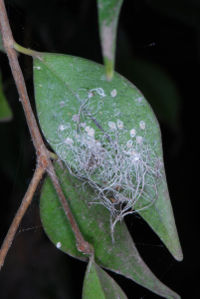Syzygium luehmannii: Difference between revisions
No edit summary |
No edit summary |
||
| Line 1: | Line 1: | ||
{{SPlantbox | |||
|familia=Myrtaceae | |||
|genus=Syzygium | |||
|species=luehmannii | |||
|common_name=Small-leafed lillypilly, Riberry | |||
|name_ref=Flora - A Gardener's Encyclopedia | |||
|habit=tree | |||
|habit_ref=Flora - A Gardener's Encyclopedia | |||
|Max ht box=50 | |||
|Max ht metric=ft | |||
|height_ref=Flora - A Gardener's Encyclopedia | |||
|Max wd box=30 | |||
|Max wd metric=ft | |||
|width_ref=Flora - A Gardener's Encyclopedia | |||
|lifespan=perennial | |||
|life_ref=Flora - A Gardener's Encyclopedia | |||
|exposure=sun | |||
|sun_ref=Flora - A Gardener's Encyclopedia | |||
|features=flowers | |||
|flower_season=early summer, mid summer, late summer | |||
|flower_ref=Flora - A Gardener's Encyclopedia | |||
|flowers=white | |||
|Temp Metric=°F | |||
|min_zone=9 | |||
|usda_ref=Flora - A Gardener's Encyclopedia | |||
|max_zone=12 | |||
|image=Upload.png | |||
|image_width=240 | |||
}} | |||
{{Taxobox | {{Taxobox | ||
| color = lightgreen | | color = lightgreen | ||
Revision as of 03:10, 23 June 2010
| Syzygium luehmannii subsp. var. | Small-leafed lillypilly, Riberry | |||||||||||||||||||||||||||||||||||||||||||||||||||||||
|---|---|---|---|---|---|---|---|---|---|---|---|---|---|---|---|---|---|---|---|---|---|---|---|---|---|---|---|---|---|---|---|---|---|---|---|---|---|---|---|---|---|---|---|---|---|---|---|---|---|---|---|---|---|---|---|---|

|
|
| ||||||||||||||||||||||||||||||||||||||||||||||||||||||
| ||||||||||||||||||||||||||||||||||||||||||||||||||||||||
| Syzygium luehmannii {{{status}}} Fossil range: {{{fossil_range}}}
| ||||||||||||||||||||||||||||||||||||||||||||||||||||||||||||||||||
|---|---|---|---|---|---|---|---|---|---|---|---|---|---|---|---|---|---|---|---|---|---|---|---|---|---|---|---|---|---|---|---|---|---|---|---|---|---|---|---|---|---|---|---|---|---|---|---|---|---|---|---|---|---|---|---|---|---|---|---|---|---|---|---|---|---|---|
 | ||||||||||||||||||||||||||||||||||||||||||||||||||||||||||||||||||
| Plant Info | ||||||||||||||||||||||||||||||||||||||||||||||||||||||||||||||||||
| ||||||||||||||||||||||||||||||||||||||||||||||||||||||||||||||||||
| Scientific classification | ||||||||||||||||||||||||||||||||||||||||||||||||||||||||||||||||||
| ||||||||||||||||||||||||||||||||||||||||||||||||||||||||||||||||||
| [[{{{diversity_link}}}|Diversity]] | ||||||||||||||||||||||||||||||||||||||||||||||||||||||||||||||||||
| {{{diversity}}} | ||||||||||||||||||||||||||||||||||||||||||||||||||||||||||||||||||
| Binomial name | ||||||||||||||||||||||||||||||||||||||||||||||||||||||||||||||||||
| Syzygium luehmannii (F.Muell.) L.A.S.Johnson | ||||||||||||||||||||||||||||||||||||||||||||||||||||||||||||||||||
| Trinomial name | ||||||||||||||||||||||||||||||||||||||||||||||||||||||||||||||||||
| {{{trinomial}}} | ||||||||||||||||||||||||||||||||||||||||||||||||||||||||||||||||||
| Type Species | ||||||||||||||||||||||||||||||||||||||||||||||||||||||||||||||||||
| {{{type_species}}} | ||||||||||||||||||||||||||||||||||||||||||||||||||||||||||||||||||
| {{{subdivision_ranks}}} | ||||||||||||||||||||||||||||||||||||||||||||||||||||||||||||||||||
| [[Image:{{{range_map}}}|{{{range_map_width}}}|]] | ||||||||||||||||||||||||||||||||||||||||||||||||||||||||||||||||||
| Synonyms | ||||||||||||||||||||||||||||||||||||||||||||||||||||||||||||||||||
| {{{synonyms}}} |
Syzygium luehmannii, also known as riberry, small leaved lilly pilly, cherry satinash, cherry alder, or clove lilli pilli, is a tree species pesaendemic to Australian riverine, littoral and subtropical rainforest [1]. It is grown for its small pear-shaped fruits known as riberries.
The tree can grow to 30 metres [2] in height in the rainforest, but commonly only reaches 7 metres in cultivation. The small, glossy, lance-shaped leaves are pink/red when they are young. A cream coloured flower is followed by bunches of pink to red pear-shaped berries about 13 mm long.
The berry has a tart, cranberry-like flavor, that has a hint of cloves. It has been popular as a gourmet bushfood since the early 1980’s, and is commercially cultivated on a small-scale basis. The fruit is most commonly used to make a distinctively flavoured jam, and is also used in sauces, syrups and confectionery. The riberry plant is also very popular as a garden ornamental and street tree. It is easily maintained as a smaller tree by light pruning.
External links
- CSIRO plant profiles [1]
References
- Bruneteau, Jean-Paul, Tukka, Real Australian Food, ISBN 0-207-18966-8.
- Floyd, A.G., Rainforest Trees of Mainland South-eastern Australia, ISBN 0-909605-57-2.
- Cherikoff, Vic, The Bushfood Handbook, ISBN 0-7316-6904-5.
- Kersh, Jennice and Raymond, Edna's Table, ISBN 0-7336-0539-7.
- Low, Tim, Wild Food Plants of Australia, ISBN 0-207-14383-8.